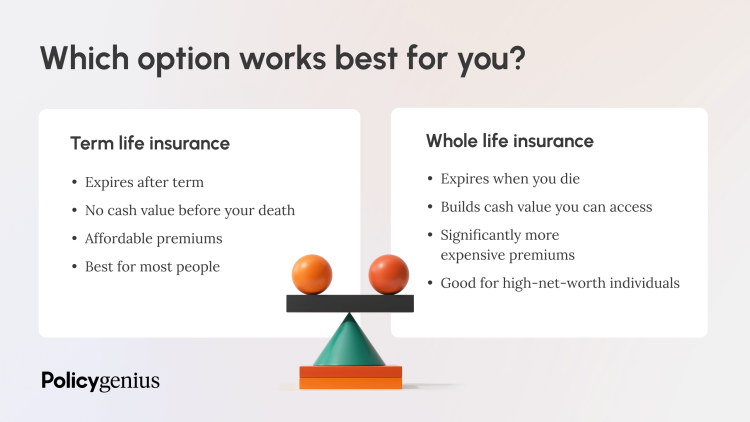Term life insurance and whole life insurance are two of the most popular types of life insurance. Knowing the differences between them will work to your advantage and ensure that you’re getting the life insurance policy that best meets your financial needs.
What is term life insurance?
Term life is a type of life insurance that provides financial protection for your family over a fixed period of time, typically somewhere between 10 and 30 years.
According to recent data, 40% of insurance policies purchased in 2022 were term life insurance policies. [1] Most people get term life insurance to protect their income, so they set the term up to last until they retire.
If you die during your term, your beneficiary will receive the payout from your policy — commonly known as death benefit — which is typically paid out as a tax-free lump sum. [2]
Pros & cons of term life insurance
Pros | Cons |
|---|---|
Affordable: Term life is cheaper than other options. Straightforward: Policies don’t come with any complex tax implications or restrictions. Coverage only when you need it: It covers you while you have important financial responsibilities, like paying a mortgage or raising children. | Expires: Term life doesn’t provide lifelong protection, since you may live longer than the term. Has no cash value component: You can’t withdraw money from term life insurance while you’re still alive. |
What is whole life insurance?
Whole life insurance is a type of permanent life insurance that doesn’t expire. Like all life insurance products, whole life policies guarantee a death benefit to your loved ones upon your death, which is most often tax-free.
But unlike term life, whole life has a cash value feature that earns interest at a fixed rate over time. You can use this cash value account when you’re alive to borrow from and in some cases, to pay your premiums.
Pros & cons of whole life insurance
Pros | Cons |
|---|---|
No expiration date: It provides financial protection for the rest of your life. Cash value: It earns interest at a set rate over time, and you can access that money while you’re alive. | Cost: Whole life insurance is significantly more expensive than term life. Investment returns: Whole life insurance offers lower returns than conventional investment options. |

What is the cost of term life vs. whole life insurance?
Whole life is significantly more expensive than term life. A 30-year-old who doesn’t smoke can expect to pay $21 per month ($249 per year) for a 20-year term life policy with a $500,000 payout, but $440 per month ($5,280 per year) for a whole life policy with the same payout. In other words, you can expect to pay up to 21 times more for a whole life policy than you would for a term life policy with the same coverage amount.
The monthly rates below will show you how other term life rates and whole life rates compare. Sample rates are for non-smokers with one or two minor health conditions with an average height-to-weight ratio.
Term life vs. whole life rates for a $500,000 policy
Age | Gender | $500,000 20-year term life insurance policy | $500,000 30-year term life insurance policy | $500,000 whole life insurance policy |
|---|---|---|---|---|
20 | Female | $18.54 | $25.73 | $287 |
Male | $23.66 | $32.49 | $334 | |
30 | Female | $18.90 | $28.02 | $408 |
Male | $22.59 | $33.55 | $472 | |
40 | Female | $28.73 | $46.81 | $588 |
Male | $34.27 | $57.95 | $706 | |
50 | Female | $63.71 | $111.61 | $920 |
Male | $81.71 | $147.61 | $1,081 | |
60 | Female | $169.25 | N/A | $1,540 |
Male | $234.59 | N/A | $1,802 |
Methodology: Average monthly term life insurance rates are for male and female non-smokers with a Preferred Plus health classification buying a 20-year or 30-year $500,000 term life insurance policy. Term life insurance averages are based on a composite of policies offered through Policygenius from Brighthouse Financial, Corebridge Financial, Foresters Financial, Legal & General America, Lincoln Financial, Mutual of Omaha, Pacific Life, Protective, Prudential, Symetra, and Transamerica. Average monthly whole life insurance rates are calculated for non-smokers in averaged Preferred Plus and Standard health classifications, obtaining a whole life insurance policy fully paid up at age 100 offered through MassMutual. Rates may vary by insurer, term, coverage amount, health class, and state. Not all policies are available in all states. Rate illustration valid as of 10/01/2024.
How to choose between term life & whole life insurance
Your reasons for buying life insurance coverage and your budget will help determine which type of policy is best for you.
You might need term life insurance if you’re looking for an affordable way to financially protect your family if you die. If your main concern is your loved ones struggling to pay expenses related to housing, childcare, or education without you around, term life insurance can fulfill that need.
You might need whole life insurance if you have a high net worth and you’re already maximizing other investment accounts, or you’re trying to minimize your estate taxes after you die. Whole life insurance is also good for people who need lifelong coverage for dependents, like an adult child with disabilities or an aging parent.
Forty-one percent of Americans say they don’t have enough life insurance coverage. [3] The best way to get the coverage you need and find the right type of policy for you is to work with an independent broker. At Policygenius, our experts are licensed in all 50 states and can walk you through the entire life insurance buying process while offering transparent, unbiased advice.
Learn more about the difference between term and permanent life insurance
Alternatives to term & whole life insurance
Term life and whole life are two of the most popular types of life insurance policies because they meet the most common coverage needs of most people. But if you have unique circumstances, you might want to consider different options, like the ones below.
Guaranteed universal life insurance is a type of permanent life insurance that comes with fixed premiums, minimal cash value, and a guaranteed death benefit.
Indexed universal life insurance (IUL) comes with a cash value that earns interest and lets you adjust your death benefit or use your cash value to pay your premiums — similar to other universal life insurance options. The interest rate is based on an index chosen by the policyholder.
Variable life insurance is a type of permanent coverage that allows you to invest the money from your cash value in various funds offered by the insurance company, including mutual funds.
Learn more about the differences between whole and indexed universal life insurance




